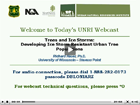April 2010 – Urban Trees & Stormwater
Webcast Resources:
“Integrating Urban Trees into Stormwater Management“
Tuesday, April 28, 2010, 11:00 AM (Eastern)
Susan Downing Day, Ph.D., Virginia Tech
» Watch the video
» Find supporting material
» Discuss this webcast
Archived Video:
You can view this month’s webcast below using the embedded video viewer. Just click on Play and the video will start momentarily. Alternatively, you may download a copy to your own PC. Simply right-click on the provided link and save the presentation to your desktop or other appropriate directory. You can then open the file once it is downloaded and view it by using the default Windows Media Player software.
Look here for Video Soon
Supporting Material:
- Susan Downing Day, Ph.D.
Virginia Tech
307D Cheatham Hall
Blacksburg, VA 24061
Tel: (540)231-7264
sdd@vt.edu
Web Links:
- Stormwater Managment Website (Virginia Tech)
- Watershed Forestry Resource Website
- Urban Trees Enhance Water Infiltration – Science Daily
Documents and Files:
- Stormwater Management Manual – Virginia Tech
- Transpiration and Root Development of Urban Trees in Structural Soil Stormwater Reservoirs
Environmental Literacy:
- Stormwater Educational Links – Environmental Protection Agency
- The Natural Inquirer – USDA Forest Service
Other Resources:
- Using Trees To Reduce Stormwater Runoff Slideshow – Center for Watershed Protection
- Watershed Management Group Website


